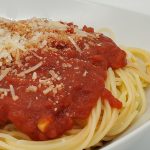Quick & Easy Marinara Sauce
Servings: 16
Calories: 85kcal
Ingredients
- ¼ cup extra virgin olive oil
- 1 cup yellow onion diced small
- ½ tbsp crushed red pepper
- 12 cloves garlic minced
- 2 28 oz cans crushed tomatoes
- 1 15oz can tomato sauce
- 1 tsp sea salt
- ½ tsp dried basil
- ½ tsp dried oregano
- 1 tsp black pepper
- 2 bay leaves
- ½ tsp sugar
- ¼ cup dry red wine
Instructions
- In a large skillet (do not use a deep pot as evaporation is important to have the right sauce consistency) heat the oil over medium heat. When it is hot, add onion and crushed red pepper, saute for about 2 minutes, until the edges start to turn translucent. Add garlic and cook an additional 2 minutes, being careful not to let the garlic over cook and turn dark.
- Add crushed tomatoes, tomato sauce, salt, basil, oregano, black pepper, bay leaves, and sugar. I like to pour the red wine in the tomato sauce can and mix it around to get all the tomato sauce out, then I pour it in the wine. You can also just scrap out the can and pour wine directly into skillet. Mix well and reduce to a slow simmer for 25 minutes. Stir occasionally to make sure sauce doesn't stick to the bottom of the pan.
- Remove bay leaves and enjoy!
Notes
You can easily use fresh herbs in this recipe. Simply substitute dried herbs for 1.5 tsp fresh herbs. Oregano is a more rugged herb so you add it to the sauce as directed, but basil is more delicate so I would recommend adding it right at the end so you don't lose it's flavor during the cooking process.
For the dry red wine I would recommend a Cabernet Sauvignon, Pinot Noir, Merlot, Zinfandel, Sangiovese, or Syrah. You just want to flavor of the wine to compliment the flavor of the sauce. You can substitute water for the wine if desired, just will just miss a little depth in flavor in the end product.
This sauce freezes really well. Just put in an airtight bag/container and freeze up to 4 months. When reheating, check consistency (sometimes marinara will thin out a bit when thawed out) as you may need to let simmer for a few minutes to get back to the thicker consistency.
Nutrition
Serving: 0.5cup | Calories: 85kcal | Carbohydrates: 11g | Protein: 2g | Fat: 3g | Saturated Fat: 1g | Polyunsaturated Fat: 1g | Monounsaturated Fat: 1g | Sodium: 478mg | Potassium: 423mg | Fiber: 3g | Sugar: 5g | Vitamin A: 487IU | Vitamin C: 10mg | Calcium: 10mg | Iron: 3mg
